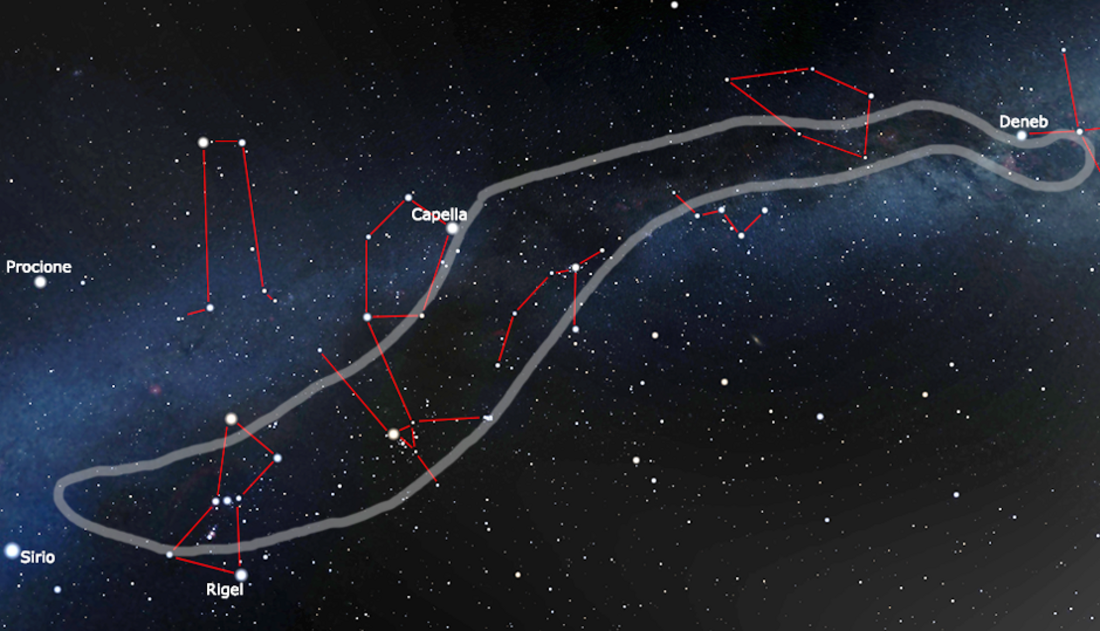Top Qs
Timeline
Chat
Perspective
Radcliffe wave
Coherent, wave-shaped gaseous structure in the Milky Way From Wikipedia, the free encyclopedia
Remove ads
The Radcliffe wave is a neighbouring coherent gaseous structure in the Milky Way, dotted with a related high concentration of interconnected stellar nurseries. It stretches about 8,800 light years.[1][2] This structure runs with the trajectory of the Milky Way arms.[3][4]

It lies at its closest (the Taurus Molecular Cloud) at around 400 light-years and at its farthest about 5,000 light-years (the Cygnus X star complex) from the Sun, always within the Local Arm (Orion Arm) itself, spanning about 40% of its length and on average 20% of its width.[5][4] Its discovery was announced in January 2020, and its proximity surprised astronomers.[1][6]
Remove ads
Formation
This page or section uses colour as the only way to convey important information. (May 2022) |
Scientists do not know how the undulation of dust and gas formed. It has been suggested that it could be a result of a much smaller galaxy colliding with the Milky Way, leaving behind "ripples", or could be related to dark matter.[1][7] Inside the dense clouds, gas can be so compressed that new stars are born.[2] It has been suggested that this may be where the Sun originated.[1]
Many of the star-forming regions found in the Radcliffe wave were thought to be part of a similar-sized but somewhat helio-centric ring which contained the Solar System, the "Gould Belt". It is now understood the nearest discrete relative concentration of sparse interstellar matter instead forms a massive wave.[1][2]
Remove ads
Discovery
The wave was discovered by an international team of astronomers including Catherine Zucker and João Alves.[8][4] It was announced by co-author Alyssa A. Goodman at the 235th meeting of the American Astronomical Society, held at Honolulu[9] and published in the journal Nature on 7 January 2020.[10] The discovery was made using data collected by the European Space Agency's Gaia space observatory.[11]
The wave was invisible in 2D, requiring new 3D techniques of mapping interstellar matter to reveal its pattern using the software Glue.[2][11][9] The proximity of the wave surprised astronomers.[1][6] It is named after the Radcliffe Institute for Advanced Study in Cambridge, Massachusetts, the place of study of the team.[11]
Remove ads
Structure and movement
The Radcliffe wave contains four of the five Gould Belt clouds:
The cloud not within its scope is the Rho Ophiuchi Cloud complex, part of a linear structure parallel to the Radcliffe wave.
Other structures in the wave, further from the local star system, are Canis Major OB1, the North America Nebula and Cygnus X.[4]
The mass of this structure is on the scale of M☉. It has a length of 8,800 light-years (2,700 parsecs) and an amplitude of 520 light-years (160 parsecs). The Radcliffe wave occupies about 20% of the width and 40% of the length of the local arm (Orion Arm). The latter is more dispersed as to its interstellar medium than the wave and has further large star-forming regions such as Monoceros OB1, California Nebula, Cepheus Far, and Rho Ophiuchi.[4]
A 2024 paper announced the discovery that the Radcliffe wave is oscillating in the form of a traveling wave.[12]
See also
- Antlia 2, another giant ripple across the Milky Way's disc found in data from the Gaia space telescope
- List of nearby stellar associations and moving groups
- Great Rift (astronomy)
- Serpens-Aquila Rift
References
Further reading
External links
Wikiwand - on
Seamless Wikipedia browsing. On steroids.
Remove ads

